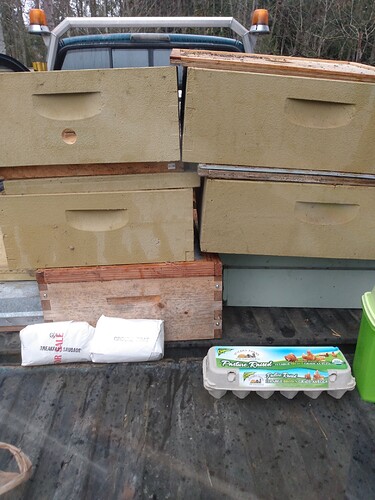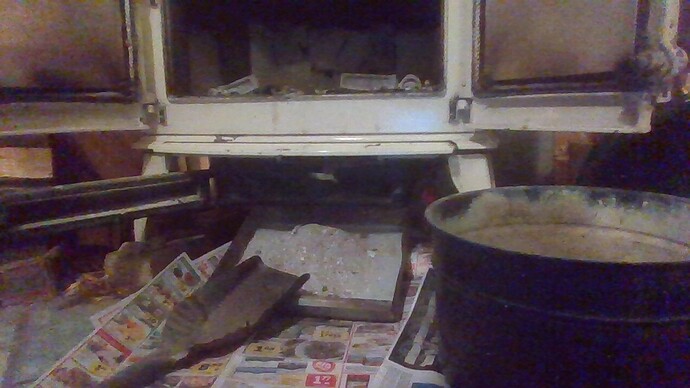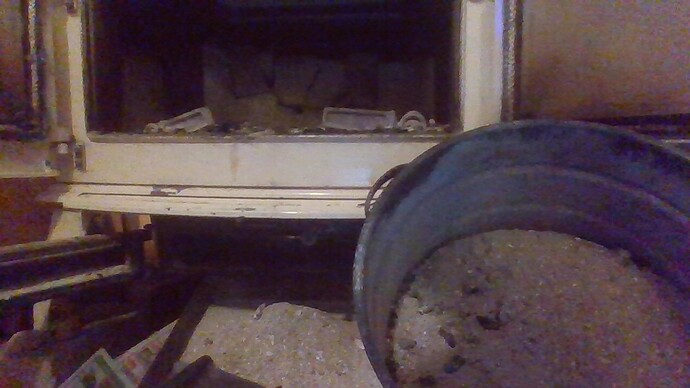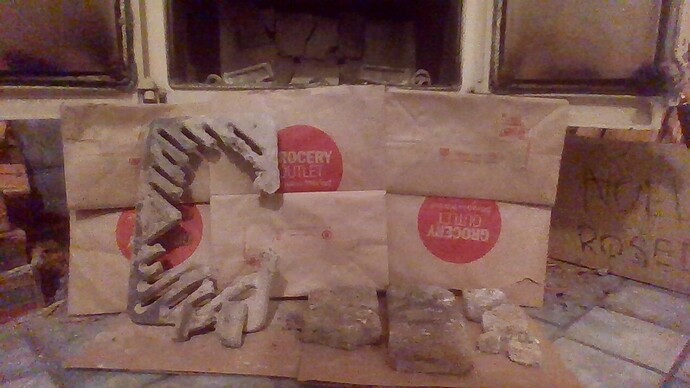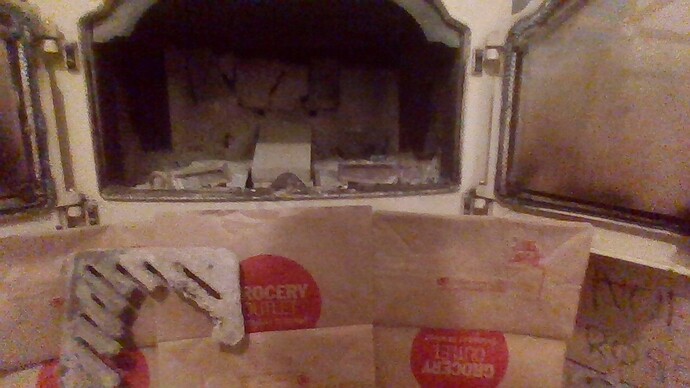I can’t recall who it was but I think I read someone ran some deer bones through there gassifier?? I almost always have beaver bones around this time of year after trapping season. After boneing them out for the meat I could save them up just to test. I was debating saving some to make a homemade bone meal to spread on the garden this year this year. And I could go out to my bobcat bait stations and gather all the bones there if I wanted as well. If it’s worth the time that’s just another use for small farm gas production. Any animal butchered or harvested just gets one more step of used/nothing wasted. But if we are talking elk/beef bones I’m eating the marrow before they get pyrolized 
Hey Steve .
I will trade you a wheelbarrow full of rattlesnakes for one of those elk 
Well trying to figure what’s best to raise on rural acreages for critters it all become a matter of what you CAN winter feed over.
Over through a no-grow six months up here in this valley.
My wife’s great GrandMa" topped out at 18-22 milking dairy cows. She squirrelled away and bought and acquired throughout her life time as a single Mother of five girls from one acre up to ~120 acres. 1920-1959.
Did not matter. She could only plow and have put into hay ~15 acres of wet foot flooding patch’s. Four feet higher and it was unplowable rocks and more rocks.
But with the previous low, low claimed working farm taxes she could with her 18-22 dairy cows make a go of it. Raise her five girls off of this land
It was dependent on direct to household delivery of her raw milk. Or come-and-get honor system from her two milk room refrigerators.
Then came the Washington State new dairy Laws that ALL milk would be Pasteurized. Stainless steel no touch pipeline from the cows udder into the stainless steel cooler tank.
Put her out of business. Broke her heart. She faltered away and died.
Her one son-in-law (later my father-in-law) got an Angus bull and bred into beef cows.
Same-same. Then 20-24 cows wintering over limit.
Turned out he had been subsidizing G.G’s and his wifes Dairy for years with then earned outside dollars working to buy out of valley real dairy alfalfa-hay and feed grains.
Beef cows that could revert to just regional grass hay hauled in one semi-truck load a year. No more feed grains.
Ha! Ha! Grass fed; near-organic range fed almost then, before that became a “thing”.
Social services Tax’s kept creeping up. So the pattern was set here in Clark County.
Unless your were BIG, BIG on full usage 100+ acres or more; some One in the family had to good pay work, commute out to pay the Taxes, fencing restores, barns; and tractors repairs.
Same for my own name Grandfather the professional welder on his 30 acres.
Same for for my oldest sisters married in family on their 60 down to 30 acres. Plywood Mills workers.
Some ONE had to commute work out for manufacturing jobs bucks to actually keep these farms afloat.
Came my turn. I opted out. I’d only ever wanted five acres.
Cows? No way. I lived that for the first half of my life.
Goats. I watched others. Even participated. It will actually work. Need some one with tiny small hands to keep the birthing losses manageable. Ugg. WE all big hands here. I can, and have pulled birth cows. Would not be able to assist goats birthing problems.
Back Dairying always pigs were kept to convert the excess out of season milk. And cows nosed aside fodders. Pig slopping foods back then gleamed form the local schools, unconsumed; and 25-35 mile distance grocery stores trimmings and spoilages.
Then . . . those too were declared illegal. So . . . .
Seeing the patterns here??? Joel Salatin’s book, “Everything I Want To DO (on my land) Is Illegal” becomes very real when you’ve a couple, of three generations lived it.
Explains why my rural family branches are so damn cranky Gov’Mint’s, hating.
Gov’Mint’s been used a the BIG-hammer tools to force us off of hands-in-soils lands working into City jobs. Then City living.
In the 18th and 19th century it was the big Industrialist forcing this. For their cheap use-up factory labor.
In the 20th century here, from 1960-63 on it has been the weeping hearts Socialist’s.
Socialization at it’s very best. The religion of We’all. So you must, too.
Anyhow. How to retain sanity is to just accept that to play their games and stay on your Five: . . . household: some-ONE’s gonna’ have to work out, earning. Accept this.
Then rejigger your Five-Acres Dreams/schemes to labor saving to accommodate 40 hours a week, with the added commuting times - gone away. That WAS me for decades. Now the nursie-Wife.
Our Property taxes on this five, this year will be $8,000. We get to buy back every 9 years everything that we own to keep it from Gov’Mint tax sale.
The Gov’Mints; the realtors/bankers/builder-beavers; want this land for more occupancies churning ATM houses.
Chickens, free range grazing are what has worked out best for us. Six months of the years I buy out very, very little feed. Place is near bug fee now. Ducks worked for us too. But none wanted their eggs, or meat. The Muscovy’s were much quieter though; without rooster wars of chickens.
And NOT selling the eggs - we do not have to state Department of Agriculture register for 50 cents a dozen taxed to pay to be inspected. We CAN gift out eggs to relatives and “friends”. And be “gifted” back occasional bags of layers pellets feed.
NOT selling the meats we side step even more odious laws and regulation for that. We can Gift out whole live chickens for meat. Side stepping, those Regs too. The responsibility then onto the killer/cleaner/meat-maker.
Actually some market for selling raised laying hens to Backyarder’s. The best selling being colorful eggs layers breeds.
We “Hobby Farmers” now.
Steve unruh
Steve as I’m reading this in my dad’s front room he just handed me a dozen fresh eggs from his prize winning road island reds, a pound of goat breakfast sausage, a pound of ground goat meat, and a jar of home grown brewed deliciose pickles. Living mini, evading the tax man on every front if possible to pinch the penny’s and keep the farm alive. The older generations of self sufficient, self sustain, and keep your cash in the mason jar is being weeded out. I was this morning gifted bee keeping goods from a local farmer as trade for removing some problem beavers and muskrats in his pond. The trade to live is coming back for those aware and wise to the goobermints ploy of control your every move
I will have to look up what that is.
Do you have issues with the wood ash? Some plants are supposedly sensitive to it. I thought Curcubits was one, but you probably wouldn’t have those in raised beds. I dumped some on a spot, then pumpkins ended up there and didn’t grow, but I don’t know if that was the ash’s fault.
I suspect you have to be a bit careful with the pH because the leftover ash will alter the pH. Otherwise I suspect it would work, but I could NOT find anyone on google who had tried it. I found a study, where added the charcoal to the fluid in tomatos made the hydroponic water less toxic, but that was it.
I probably need to try vermiculture. I have a huge tote I can use, but I heard that was a lot better for kitchen scraps then just straight composting them in part because it keeps the critters from being interested in the pile.
How does the compost tea work? can I apply that with a foliar sprayer? Do I need worm castings in the mix? I want to do the garden and the yard. I need to fix the bacteria issue, I think the soil is compacted and favors the anaerobic bacteria which is my main issue. The anaerobic bacteria are the ones that typically eat, and lock up the nitrogen. I am not quite sure how I am fully going to address this, yet. Do you add the coffee grounds to the worms or the compost?
Now referring back to my statement on #63:
“Then rejigger your Five-Acres Dreams/schemes to labor savings to accommodate a 40 hours a week, with added commuting times - gone away.”
And now here is where your small engine equipment’s come into play.
And I’ve come to favor alone standing air cooled crank started IC engine equipment’s for these 2-8 horsepower speed-work needs.
Everything battery starting makes more work maintain a battery and electric starter.
Many manufactures make woman friendly “Easy-Start” spring loading systems.
Some are going into universal portable battery systems.
These are still in evolution shaking out.
You WILL, so far, pay more over the course of five years usages.
I expect these to evolve stabilize out within the next 10 years.
But even then when time crunched; get-done-before-dark; true working comparable to IC engines portable-battery is real, with hot swapping spare battery pacs!!!
Bluntly living on Five acres you will be ditching out power edging around the side walks for out power weed-eating around fenced off not grazed bits like protected fruit and nut trees. Bases of berries and grapes.
Leave the Urban perfect yards fantasies for the tiny lots Urbans. Which is derived from back in the Manor Estates with many servants days.
DO NOT Enslave yourself appearances keeping up with the Fancy-Pants. The Net addicted. The buy-this, Spin Doctors.
Think it out THREE times before buying and committing. That hard earned, after-taxes, Away Money only spends for you one time. Make it stretch. Make it serve for maximum labor saving value returned to you.
Pretty and Fashionable means n-o-t-h-i-n-g.
Functions; and lowest long-term usage costs are everything.
Steve Unruh
Don’t mistake me for a real grower Sean. I have a lot more screw up’s than successes but I’m getting a little more proficient each year. When I mentioned John Jeavon’s systems they go back to a MEN article in about 1970. He’s still working and promoting bio-dynamics . I think this system goes back to Rudolph Steiner back in the 18th century.
http://www.growbiointensive.org/
I have never had problems with wood ash but I use it instead of lime and I check the PH in my beds regularily. I don’t know where you live but getting soil tested in Michigan is a little pricey. Some states it’s much more reasonable. Because I have raised beds and each bed has to be tested separately I just use these,
I think if you have had problems with wood ash with some plants it’s just a matter of too much of a good thing. Just like wood gasification, growing is a lot of trial and error. The perlite is just a medium for the roots to spread out into where they can get a periodic drench from the nutrient solution. The solution runs past the roots, they absorb a portion of the nutrients and the rest drains back to the pump reservoir. The perlite is inert. Crushed char on the other hand absorbs a lot of moisture and whatever is in the moisture. If you take a plant and mix freshly ground char into the soil mix it will suck all the nutrients out of the mix and you won’t get crap out of the plant. I’m not talking about the char you may broadcast over your soil to mix in. The percentage of that is too small to have any great immediate effect but will retain excess nutrients as time passes so is a great long term benefit. Some people make the mistake of over amping their planting mix with char. As for the dutch buckets, I’m thinking that char instead of perlite would hold nutrients so that the pump feed cycles would be less. Of course each time the solution passes through the buckets some is dissipated. The other thing is you get about four or five buckets out of a 4 cubic ft bag of perlite. That becomes a significant expense.
I just started with the dutch buckets and kraky two years ago. Not a lot of data yet but I have friends that are big into it for even market gardening and love it because once the systems are set up they are just about self sustaining. Most are growing tomatoes and other than clipping suckers and keeping the plants trimmed for maximum light exposure there is only harvesting. People talk about hydro veggies and fruits as being tasteless. That’s BS. Seems like I just lost a bunch of this post.
About vermiculture Sean. In my opinion it’s the best thing a gardener can get into. I have had my worms about four years. I got them from Uncle Jim’s worm farm
Seems a little expensive for a hand full of worms but they are little marvels. No real effort involved. Take a tote or a bucket. get some air holes drilled in and covered with screen so the can’t escape throw in some shredded paper or leaves and sprinkled food scraps, coffee grounds, manure, but now citrus, meat or dairy and pop a lid on it. Every few months sift the worms out of the castings and start over. They will double their numbers every few months and process their weight in food every day.
I through a portion of the food scraps in a blender and mix it up with water to make a slurry to sprinkle over the bed because they like a moist environment and will incorporate the stuff in the slurry into the castings. I also mix green leaves, and food scraps, especially banana peels in the blender and make my compost tea out of that in a bucket with an air stone from a aquarium in the bottom. Also mix a portion of worm castings in and let it sit of a while. I add a little epsom salts for magnesium, some bone meal, some baking soda and urine in while its working and then strain it through a paint strainer for a folular spray and the more solid stuff gets mixed in the planting hole soil mix. I pre-start all my salad crops and some squash and pumpkins so I just scoop out a small hole, place some mix in the bottom, stick in the plant and replace the soil with regular compost. You can probably tell I love doing this stuff.
Experience is about learning from your mistakes. ![]() It is part of the reason why ag seems to adopt trends slowly. This worked! lets keep doing it, rather then explore new territory that has it’s own learning curve.
It is part of the reason why ag seems to adopt trends slowly. This worked! lets keep doing it, rather then explore new territory that has it’s own learning curve.
I’m in michigan down by lansing. Michigan State has/had the cheapest soil tests, but I don’t know if that is still true. They are expensive all over because it is a time consuming and tedious process and the reagents are expensive, and do go bad… A soil test kit with the reagents is like 500 bucks for micros, and the majority of the cost is the reagents.
It is also kind of why I was looking at the Elaine Lansing’s method, because she was more focused on assaying the bacteria/fungus/nematodes in live soil under a microscope, which significantly cheaper and faster to do at home then sending in a soil sample. How many soil samples are the equivalent of a 400x microscope and slides? Not very many especially if you are assaying the full range of micro nutrients.
Actually don’t think they even need a medium, but the plants don’t stay stable and upright without it. You could use sand or gravel as well, but I suspect the small particles are abrasive in the equipment.
right. I think if I was going to try it with hydroponics, I would presoak by running the system on it for a few days it without plants until it stabilized. Which is more work then perlite, and along with the work to make charcoal, it doesn’t make sense for a lot of people.
I will just find some red wigglers. Uncle Jim’s name has popped up for years. Chances are even the ones sold at the bait shop are originally from Uncle Jim. ![]() Or I could dig some up.
Or I could dig some up.
I have a 45 gallon tote, that i curb shopped, and it is too big for anything so I might use that. I have to read up on this some more.
Yes, I think you could use a lot of different media in the buckets because as you said they are only there to give the roots some structure. The problem with gravel would be too much limestone but I guess if you could find some crushed granite it would be fine. I’m all about finding materials to work with that don’t require me to be store dependent. So far any kind of hydroponics requires store bought solutions. The MHP gardener I posted has a lot of experience in these systems and had tried everything but has found no organic solutions that give real satisfactory results. That’s why I was going into aquaponics. That is a self sustaining system but energy intensive.
Try a couple of Kraky containers. Just a container with a way to hold the plant in the top of it. Roots dangle into the nutrient solution and as long as there is an airspace above the solution they plant thrives. Just interesting to mess with. I use mesh cups with rock wool in them for seed starting. There are a lot of people in you-tube world doing some very interesting things.
We are into fall now , i still have a few Kraky buckets up stairs in my sun room that i hope will grow through the fall and winter , i am trialing growing tobacco seeds just because i was shown how hard they are to get going and so i did a test i shook some seeds into pearlite some into charcoal dust that’s been sat outside for over a year and some into store bought potting compost mix .
The charcoal dust was the runaway winner by miles followed by the pearlite , the potting mix was a no go none took off and anyway i lost interest a bit after that as they were so small and did nothing for weeks after sprouting , i did the occasional water spray over them but the charcoal ones died due to what i think may have been over watering , but the pearlite ones continued to grow with my abuse .
I was taking out the side shoots from my tomatoes a while back and typical of me could not throw them away and so just stuck them into that charcoal seed tray that the tobacco was in and a drop more water 3 weeks later they re growing like mad and even flowering so will transfer them into buckets and see if i can grow them during our winter here .
I only skimmed this topic. Yes, read the book about 15 years ago and it has a lot of good point.
I have a mixture of old and high tech. Charcoal gasifiers, no battery needed small engines, high tech lithium power tools (old stuff too) and a nice simple solar set up. Also using 31 group batteries. They all work great. No problems to write about. Wish I had this set up 30 years ago. Sure makes life more enjoyable. Switching out the group 31 for lithium would work out good for me and if they failed I could swap back to the group 31.
Made a tiny amount of progress on the new log hauler (and portable generator) and new gasifier. Because of pure dumb luck, I ended up with an interesting new grate scheme. If it wasn’t for dumb luck I would have no luck at all . . .
Keep the spirits up.
Morning All
As KristijanL. showed with his wood-heating-cooking-hot water making stove . . .
keep your systems simple and useable.
My last nights space heating wood stove ash cleaning out. Once every two weeks from reduced down about 14 wheelbarrows worth this time a year.
As you see no charcoal left with my Douglas Fir wood and my system of completely clean burning.
And this keeps my Greens neighbors unaware I am even trees-killing-raping their idealistic froo-froo World.
And keeps my chimney clean and free flowing.
Steve unruh
Hi Steve what brand and model is the fireplace stove you have There?
Bob
QuadraFire; Royal Isle.
From Washington state a couple of counties east of you BobMac.
Ha! Ha! On my own I’d have one of their stepped top all black plate steel stoves. A 4300.
Sigh. But this pretty wifies porcelain enamel beauty has taught me lessons too. I must burn very hot and slow flow to milk the heat out of it. And that has killed the cast steel grate. The lesson was to filling the grate center hole with thermal bricks.
Next go cold I’ll remove them and picture that.
S.U.
Thank you that might be perfect for me. It is easy. I can probably skip half the work by not using his loading process… Im not going to take 3 hours to fill it. ![]()
I have seen a bit of Gabe Brown before. He has the right idea and actually University of ND actually has seemingly a pretty good soil science program as well. BUT I had seen a congressional meeting like that which I think was interesting how law makers were interpreting what he was trying to say… there is a gap there.
O.K.
Here is my original 25 pounds (11 kilogram) cast iron grate. Ha! Now center burnt out and I am sure converted to cast steel.
I had been loose-lay bricking over the burnt out center; leaving gaps.
Pulled out for this picture I will try just gap loose-lay bricking across the whole grate support hole now.
So see, in the past that I’ve said heat-hammer the wood&char for best conversions results, this has been based on doing it for thousands of hours.
And when I’ve said drive up your sustained temperatures to materials failures. Do not back off your now proven heat. THEN, redesign to endure that. This advice too has been based on doing exactly that.
Just so.
Actually Living on Five acres it is about try, try, try. Thoughtfully. Keep what works - for you - for your circumstances, as good’nuff.
And be flexible enough to try again. Recognizing when to back off back to the already proven.
But always be results driven. And goals orientated.
Not for you the willy-nilly of following the latest book; or designs fashions driven trends.
Making the Five acres as self-standing as possible you do not have the Inputs in time, sweat, and money to waste chasing the Perfections.
It really is all about match balancing; Inputs and Outputs.
Keep it real.
Keep it relevant.
All else is for the artists, priests and politicians.
Steve unruh
Hey Steve, you should try making your own grate with inverted angle iron like we do in gasifiers and see how long that lasts. The only problem I see with that is the longer lengths needed to span the distance. You would still need some bricks for support.
This Bill was mentioned , This Bill is dead .
H.R. 2859/S. 1620 Processing Revival and Intrastate Meat Exemption (PRIME) Act
This bill amends the Federal Meat Inspection Act to expand the exemption of custom slaughtering of animals from
federal inspection requirements. Under current law, the exemption applies if the meat is slaughtered for personal,
household, guest, and employee use. The bill expands the exemption to include meat that is: slaughtered and prepared
at a custom slaughter facility in accordance with the laws of the state where the facility is located; and prepared
exclusively for distribution to household consumers in the state or restaurants, hotels, boarding houses, grocery stores,
or other establishments in the state that either prepare meals served directly to consumers or offer meat and food
products for sale directly to consumers in the state. The bill does not preempt any state law concerning: (1) the
slaughter of animals or the preparation of carcasses, parts thereof, meat and meat food products at a custom slaughter
facility; or (2) the sale of meat or meat food products.
Status: HR 2859 was introduced by Rep. Thomas Massie (R-KY-4) on May 21, 2019 referred to the House Committee on
Agriculture, Subcommittee on Livestock and Foreign Agriculture. S. 1620 was introduced on May 22, 2019 by Senator
Angus King (I-ME) and referred to the Senate Committee on Agriculture, Nutrition, and Forestry.
S.1620 - PRIME Act
Introduced in Senate (05/22/2019)
Processing Revival and Intrastate Meat Exemption Act or the PRIME Act
This bill expands the exemption of custom slaughtering of animals from federal inspection requirements.
Under current law, the exemption applies if the meat is slaughtered for personal, household, guest, and employee uses. The bill expands the exemption to include meat that is
slaughtered and prepared at a custom slaughter facility in accordance with the laws of the state where the facility is located; and
prepared exclusively for distribution to household consumers in the state or restaurants, hotels, boarding houses, grocery stores, or other establishments in the state that either prepare meals served directly to consumers or offer meat and food products for sale directly to consumers in the state.
The bill does not preempt any state law concerning (1) the slaughter of animals or the preparation of carcasses, parts thereof, meat and meat food products at a custom slaughter facility; or (2) the sale of meat or meat food products.
